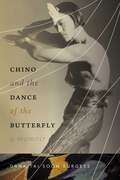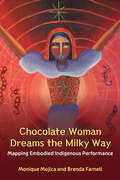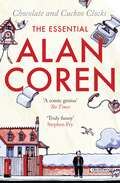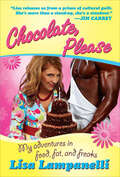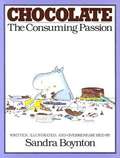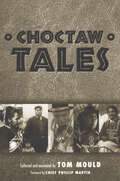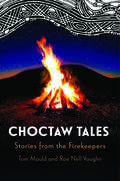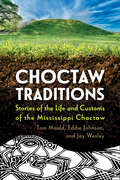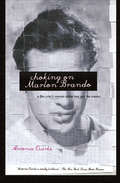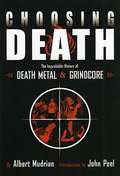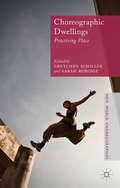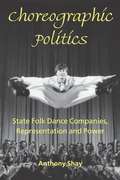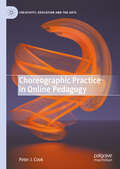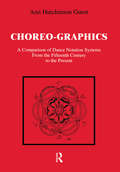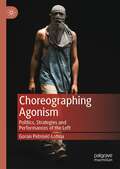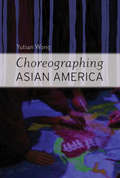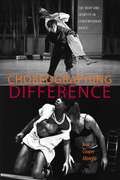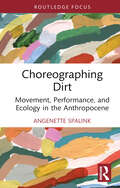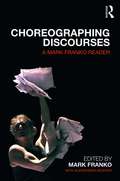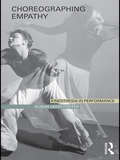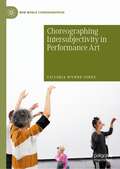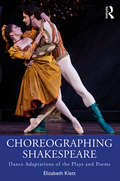- Table View
- List View
Chino and the Dance of the Butterfly: A Memoir
by Dana Tai BurgessRenowned Korean American modern-dance choreographer Dana Tai Soon Burgess shares his deeply personal hyphenated world and how his multifaceted background drives his prolific art-making in Chino and the Dance of the Butterfly. The memoir traces how his choreographic aesthetic, based on the fluency of dance and the visual arts, was informed by his early years in Santa Fe, New Mexico. This insightful journey delves into an artist&’s process that is inspired by the intersection of varying cultural perspectives, stories, and experiences. Candid and intelligent, Burgess gives readers the opportunity to experience up close the passion for art and dance that has informed his life.
Chocolate Woman Dreams the Milky Way: Mapping Embodied Indigenous Performance (Theater: Theory/Text/Performance)
by Brenda Farnell Monique MojicaThis volume documents the creation of Chocolate Woman Dreams the Milky Way, a play written and performed by Monique Mojica with collaborators from diverse disciplines. Inspired by the pictographic writing and mola textiles of the Guna, an indigenous people of Panama and Colombia, the book explores Mojica’s unique approach to the performance process. Her method activates an Indigenous theatrical process that privileges the body in contrast to Western theater’s privileging of the written text, and rethinks the role of land, body, and movement, as well as dramatic story-structure and performance style. Co-authored with anthropologist Brenda Farnell, the book challenges the divide between artist and scholar, and addresses the many levels of cultural, disciplinary, and linguistic translations required to achieve this. Placing the complex intellect inherent to Indigenous Knowledges at its center, the book engages Indigenous performance theory, and concepts that link body, land, and story, such as terra nullius/corpus nullius, mapping, pattern literacy, land literacy, and movement literacy. Enhanced by contributions from other artists and scholars, the book challenges Eurocentric ideologies about what counts as “performance” and what is required from an “audience,” as well as long-standing body-mind dualisms.
Chocolate and Cuckoo Clocks: The Essential Alan Coren
by Alan CorenA hilarious anthology of comic treasures written by Britain&’s &“comic genius&”—the former editor of Punch and beloved regular on BBC&’s Radio 4 (The Times). Alan Coren was one of contemporary Britain&’s most prolific humorists. Over his forty-year career, Coren wrote comic and satirical pieces for The New Yorker, The Times, Observer, Tatler, Daily Mail, Mail on Sunday, and Punch, and published more than twenty books including The Sanity Inspector, Golfing for Cats and The Collected Bulletins of Idi Amin. This anthology draws together the best of Coren&’s previously published material as well as never-before-published autobiographical material. In these pages, you will find the queen at a loose end playing I-Spy, QPR fans arguing at the cheese counter, prank phone calls to Mao Tse-Tung, the Roman tax collector Glutinus Sinus dealing with the mud-caked Britons, Gatling guns, an Italian driving school, herons, hearing aids, hosepipe bans, talking parrots . . . Welcome to the wonderful world of the late, great Alan Coren! &“Truly funny.&” —Stephen Fry, actor, producer, director, and author of The Hippopotamus
Chocolate, Please: My Adventures in Food, Fat, and Freaks
by Lisa LampanelliAn inside look at the life of Comedy's Lovable Queen of Mean, Lisa Lampanelli, as she dishes on everything from relationships, food, and fat to why once you go black, you never go back In her jaw-droppingly hilarious and politically incorrect memoir, Lisa reveals all—including the dysfunctional childhood that made her the insult comic she is today, the subject for which she's best known (black men, black men, and more black men), and her hilarious struggles with her addiction to food and hot guys. By telling her story in her very real, very candid, very open way, Lisa shows her audience that it's okay to be yourself, even if it's just one rehab stint at a time. Lisa also takes readers behind the scenes at the roasts that have marked her comedy career and launched her into the comedy elite, and reveals the important "firsts" in her career, including her first time on her hero's program, The Howard Stern Show.Chocolate, Please is a side-splittingly funny portrait of the woman behind the award-winning insult comedy.
Chocolate: The Consuming Passion
by Sandra BoyntonA New York Times bestseller with over a half-million copies in print, CHOCOLATE continues to delight chocoholics everywhere. Packed with Boynton's famous hippos, bunnies, pigs, and other animals, this gift-perfect book is a whimsical commentary on the individual's relationship to chocolate, its varieties, and its sources. From the several sorts of chocolate connoisseur-including the gourmoo, who eats only milk chocolate-to the several shapes of chocolate itself (bunny, kiss, glove compartment bar), Boynton's apologia for chocolate misses nothing. Myths are debunked: chocolate is not fattening, she argues, especially when the caloric expenditure of carrying it home from the store and hiding it from company is factored in. Directions are supplied: to remove stains, lick them. Plus, how to grow chocolate at home, a foolproof method for determining if chocolate is in season (does the name of the month contain the letter A, E, or U?), and a recipe for Hippo Pot de Mousse. "Fourteen out of ten people like chocolate," says the artist. This is the only guide for people who like chocolate the way they like to breathe. Vanilla people, keep out. Selection of the Literary Guild.
Choctaw Tales
by Tom MouldIncluding stories from the 1700s to today, Choctaw Tales showcases the mythic, the legendary and supernatural, the prophecies and histories, the animal fables and jokes that make up the rich and lively Choctaw storytelling tradition. The stories display intelligence, artistry, and creativity as Choctaw narrators, past and present, express and struggle with beliefs, values, humor, and life experiences. Photographs of the storytellers complement the text. For sixteen tales, the Choctaw-language version appears in addition to the English translation. Many of these stories, passed down through generations, address the Choctaw sense of isolation and tension as storytellers confront eternal, historical, and personal questions about the world and its inhabitants. Choctaw Tales, the first book to collect these stories, creates a comprehensive gathering of oral traditions from the Mississippi Band of Choctaw Indians. Each story brings to life the complex and colorful world of the Choctaw tribe and its legend and lore. The shukha anumpa include tall tales, jokes, and stories of rabbits, turtles, and bears. The stories of the elders are populated by spirits that bring warnings and messages to the people. These tales provide a spectrum of legend and a glimpse of a vibrant, thriving legacy.
Choctaw Tales: Stories from the Firekeepers
by Tom Mould Rae Nell VaughnFrom the earliest stories recorded among the Choctaw in the 1700s to the most recent stories being told today, Choctaw Tales: Stories from the Firekeepers amasses the most comprehensive collection of oral traditions of the Mississippi Band of Choctaw Indians ever published. Originally published in 2004, Choctaw Tales was a celebration of the art of storytelling, including myths, legends, supernatural tales, prophecies, historical anecdotes, tall tales, and animal stories. Through these stories, which include fifty new stories in this edition, Choctaw narrators create, express, and negotiate their beliefs, values, humor, and life experiences, as well as those of their ancestors before them. Their stories display the intelligence, artistry, and creativity of storytellers past and present. Choctaw Tales includes new and expanded materials to keep this valued resource current. Nestled in the middle of Mississippi woodlands, the Choctaw have long been an elusive community to outsiders. Racial prejudice and historical mistreatment made the Choctaw wary of their neighbors. Many of their stories address this tension, both subtly and boldly. Virtually all the stories tackle either cosmological, historical, relational, or personal questions about the world and its inhabitants, offering complex responses in the guise of seemingly simple stories. For the Choctaw audience, the stories often need little explanation. However, a series of essays on Choctaw storytelling, coupled with careful annotation of each story and short biographies of each storyteller, help make this vibrant oral tradition understandable to today’s general audiences.
Choctaw Traditions: Stories of the Life and Customs of the Mississippi Choctaw
by Eddie Johnson Tom Mould Jay WesleyThere are thousands of books that record the oral traditions of Native peoples, documenting their myths, legends, folktales, and tribal histories. Yet, there are almost none that pay the same attention to the oral traditions that make up the other 95 percent of Native American storytelling: the personal, familial, humble stories that convey the depth of cultural knowledge, traditional practices, and lived experience of Native peoples today.Choctaw Traditions: Stories of the Life and Customs of the Mississippi Choctaw draws on over 1,400 stories from interviews with over one hundred tribal members, past and present, from all of the nine Choctaw communities in Mississippi and Tennessee. This breadth creates a collection of stories capturing the rich detail and complexity of Choctaw customary life. Archival stories offer a glimpse into the past, but the vast majority of the stories were recorded over the past three decades, a collaboration between Choctaw youth, Choctaw elders, Choctaw leaders, and a folklorist.In their own words, Choctaw elders tell stories of participating in customs and traditions—stories about growing up sharecropping, where the work to put food on the table was balanced with weekends of ballgames, picnics, and dancing. They recount stories of helping each other when an iyyikowa was called to help their neighbors in need, and in gathering seasonally for ceremonies, holidays, festivals, and fundraisers. Important customs that structure lives from cradle to grave come to life through stories about the dos and don’ts of pregnancy and birth, coming of age, courtship, weddings, marriage, parenting, deaths, wakes, and funerals. With these stories, Choctaw elders offer a blueprint for how to live.
Choking on Marlon Brando: A Film Critic's Memoir About Love and the Movies
by Antonia QuirkeIn this witty and bittersweet memoir, the film critic shares her misadventures as a lover of film stars who seeks movie romance in the real world. Antonia Quirke was ten years old when she first saw Marlon Brando in A Streetcar Named Desire. It was the first film she ever saw, and her reaction was so intense that her parents called an ambulance. So began her lifelong love of movies—an obsession that has brought as much drama and comedy to her actual life as she sees on screen. In Choking on Marlon Brando, Quirke offers a window into her life as a film critic, her unabashed infatuation with male screen idols, and her many real-life romances that never quite make the cut. We learn of her personal ad seeking Tom Cruise, and her bungled interview with Jeff Bridges; the writer boyfriend who never brushed his teeth, and the actor boyfriend whose family showed up nude to a party. Along the way, Quirke provides witty insight into the nature of celebrity, fandom, the movies we all love, and how different they are from reality. “Fans of snappy writing, movie actors and dead-end romance will find Quirke’s book a treat.” —Publishers Weekly
Choose It! Videogame Edition
by Welbeck Children's BooksThis book is full of fun, clever and extremely silly "Would You Rather" questions starring your favorite videogame characters and worlds. Some might make you think, and others might make you laugh. Either way, YOU supply the answer!Would you rather fight four Mario-sized Bowsers, or one Bowser-sized Mario? Would you rather sniff Sonic's stinky sneakers, or Tom Nook's underpants? Would you rather eat soup made of goombas, or a Koopa Trooper sandwich? Would you rather be an exploding Creeper, or a Pac-Man ghost? All these and many more gaming-related "Would You Rather" questions are inside, complete with fun illustrations, silly gaming jokes and a top selection of gaming facts!
Choosing Death: The Improbable History of Death Metal and Grindcore
by Albert MudrianThis exciting history, featuring an introduction by famed DJ John Peel, tells the two-decade-long history of grindcore and death metal through the eyes and ringing ears of the artists, producers, and label owners who propelled them.
Chords of Strength: A Memoir of Soul, Song, and the Power of Perseverance
by David ArchuletaSinging sensation and American Idol favorite David Archuleta tells his inspiring personal story. A runner-up on American Idol and successful music artist, David Archuleta was named one of the "breakout stars of 2008" by Forbes magazine and landed the number two spot on the Billboard charts. In Chords of Strength, David shares his unexpected and inspiring journey, including how he overcame vocal cord paralysis to achieve his dream of being a singer. He reveals insecurities he felt about his voice - before he realized that he loved the way singing made him feel more than he disliked the way he sounded. In this personal memoir, David opens up about the strength he draws from his unshakable faith and unyielding family. He pays tribute to those who continue to inspire him and through their example help him believe in himself, his talent, and his abilities. Intimate and uplifting, Chords of Strength allows a unique glimpse of the man behind the music and offers hope to anyone with a passion and a dream.
Choreographic Dwellings
by Gretchen Schiller Sarah RubidgeChoreographic Dwellings explores performance practices that extend the remit of the choreographic. Covering walking practices, site-specific and nomadic performance that explore the movement potentials of everyday environments, parkour and art installation, it offers a reframing of the topologically kinaesthetic experience of the choreographic.
Choreographic Dwellings: Practising Place (New World Choreographies)
by G. Schiller S. RubidgeChoreographic Dwellings: Practising Place offers new readings of the kinaesthetic experiences of site-specific and nomadic performance, parkour, installation and walking practices. It extends the remit of the choreographic by reframing the kinaesthetic qualities of place as action.
Choreographic Politics: State Folk Dance Companies, Representation and Power
by Anthony ShayOver the past fifty years national dance companies from Turkey, Egypt, Mexico, Greece, the former USSR and Croatia have dominated concert stages throughout the world. Anthony Shay makes coherent sense of these national programs, which have previously received scant academic attention. Specifically, he looks at the ways through which these companies spread political, ethnic and cultural messages by accruing symbolic and cultural capital for their respective nation-states. In his analysis, Shay draws on cultural studies, political science and anthropology to create a work that cuts across disciplines. As the first book to address the topic of state-sponsored folk dance ensembles and their structures, Choreographic Politics examines the repertoires, performances and choreographic strategies of these companies within the political, social, gendered and ethnic contexts in which each company was created. In addition, Shay's study includes a look at music, costumes, and various artistic directors and choreographers.
Choreographic Practice in Online Pedagogy (Creativity, Education and the Arts)
by Peter J. CookThis book examines a creative approach to exploring choreographic practice artistically, theoretically, and pedagogically. It explores the interweaving of dance, dance teaching, dance onto-epistemologies, and choreography with a particular focus on creating dance with digital technologies. The idea of centring choreography in dance education fundamentally challenges typical conceptions of best practice in the preparation and delivery, appropriateness, and effectiveness of dance performance, teaching and learning experiences. It purposefully privileges creativity as a critical learning paradigm, extending the ways in which creativity studies are enriching performance scholarship as well as performance teaching. The book acknowledges the importance of the artist teacher nexus and presents choreographic practice as the centre of learning in dance, with a focus on digital platforms.
Choreographics: A Comparison of Dance Notation Systems from the Fifteenth Century to the Present
by Ann Hutchinson GuestHere for the first time is an account of how each of thirteen historical as well as present-day systems cope with indicating body movement, time, space (direction and level) and other basic movement aspects of paper. A one-to-one comparison is made of how the same simple patterns, such as walking, jumping, turning, etc. are notated in each system.
Choreographing Agonism: Politics, Strategies and Performances of the Left
by Goran Petrović-LotinaIn Choreographing Agonism, author Goran Petrović Lotina offers new insight into the connections between politics and performance. Exploring the political and philosophical roots of a number of recent leftist civil movements, Petrović Lotina forcefully argues for a re-imagining of artistic performance as an instrument of democracy capable of contesting a dominant politics.Inspired by post-Marxist theories of discourse theory, hegemony, conflict, and pluralism, and using tension as a guiding philosophical, political, and artistic force, the book expands the politico-philosophical debate on theories of performance. It offers both scholars and practitioners of performance a thought-provoking analysis of the ways in which artistic performance can be viewed politically as ‘agonistic choreo-political practice,’ a powerful strategy for mobilising alternative ways of living together and invigorating democracy.Choreographing Agonism makes a bold and innovative contribution to the discussion of political and philosophical thought in the field of Performance Studies.
Choreographing Asian America
by Yutian WongPoised at the intersection of Asian American studies and dance studies, Choreographing Asian America is the first book-length examination of the role of Orientalist discourse in shaping Asian Americanist entanglements with U.S. modern dance history. Moving beyond the acknowledgement that modern dance has its roots in Orientalist appropriation, Yutian Wong considers the effect that invisible Orientalism has on the reception of work by Asian American choreographers and the conceptualization of Asian American performance as a category. Drawing on ethnographic and choreographic research methods, the author follows the work of Club O' Noodles--a Vietnamese American performance ensemble--to understand how Asian American artists respond to competing narratives of representation, aesthetics, and social activism that often frame the production of Asian American performance.
Choreographing Difference: The Body and Identity in Contemporary Dance
by Ann Cooper AlbrightThe choreographies of Bill T. Jones, Cleveland Ballet Dancing Wheels, Zab Maboungou, David Dorfman, Marie Chouinard, Jawole Willa Jo Zollar, and others, have helped establish dance as a crucial discourse of the 90s. These dancers, Ann Cooper Albright argues, are asking the audience to see the body as a source of cultural identity -- a physical presence that moves with and through its gendered, racial, and social meanings.Through her articulate and nuanced analysis of contemporary choreography, Albright shows how the dancing body shifts conventions of representation and provides a critical example of the dialectical relationship between cultures and the bodies that inhabit them. As a dancer, feminist, and philosopher, Albright turns to the material experience of bodies, not just the body as a figure or metaphor, to understand how cultural representation becomes embedded in the body. In arguing for the intelligence of bodies, Choreographing Difference is itself a testimonial, giving voice to some important political, moral, and artistic questions of our time.Ebook Edition Note: All images have been redacted.
Choreographing Dirt: Movement, Performance, and Ecology in the Anthropocene (Routledge Studies in Theatre, Ecology, and Performance)
by Angenette SpalinkThis book is an innovative study that places performance and dance studies in conversation with ecology by exploring the significance of dirt in performance. Focusing on a range of 20th- and 21st-century performances that include modern dance, dance-theatre, Butoh, and everyday life, this book demonstrates how the choreography of dirt makes biological, geographical, and cultural meaning, what the author terms "biogeocultography". Whether it’s the Foundling Father digging into the earth’s strata in Suzan-Lori Park’s The America Play (1994), peat hurling through the air in Pina Bausch’s The Rite of Spring (1975), dancers frantically shovelling out fistfuls of dirt in Eveoke Dance Theatre’s Las Mariposas (2010), or Butoh performers dancing with fungi in Iván-Daniel Espinosa’s Messengers Divinos (2018), each example shows how the incorporation of dirt can reveal micro-level interactions between species – like the interplay between microscopic skin bacteria and soil protozoa – and macro-level interactions – like the transformation of peat to a greenhouse gas. By demonstrating the stakes of moving dirt, this book posits that performance can operate as a space to grapple with the multifaceted ecological dilemmas of the Anthropocene. This book will be of broad interest to both practitioners and researchers in theatre, performance studies, dance, ecocriticism, and the environmental humanities.
Choreographing Discourses: A Mark Franko Reader
by Mark FrankoChoreographing Discourses brings together essays originally published by Mark Franko between 1996 and the contemporary moment. Assembling these essays from international, sometimes untranslated sources and curating their relationship to a rapidly changing field, this Reader offers an important resource in the dynamic scholarly fields of Dance and Performance Studies. What makes this volume especially appropriate for undergraduate and graduate teaching is its critical focus on twentieth- and twenty-first-century dance artists and choreographers – among these, Oskar Schlemmer, Merce Cunningham, Kazuo Ohno, William Forsythe, Bill T. Jones, and Pina Bausch, some of the most high-profile European, American, and Japanese artists of the past century. The volume’s constellation of topics delves into controversies that are essential turning points in the field (notably, Still/Here and Paris is Burning), which illuminate the spine of the field while interlinking dance scholarship with performance theory, film, visual, and public art. The volume contains the first critical assessments of Franko’s contribution to the field by André Lepecki and Gay Morris, and an interview incorporating a biographical dimension to the development of Franko’s work and its relation to his dance and choreography. Ultimately, this Reader encourages a wide scope of conversation and engagement, opening up core questions in ethics, embodiment, and performativity.
Choreographing Empathy: Kinesthesia in Performance
by Susan Foster"This is an urgently needed book � as the question of choreographing behavior enters into realms outside of the aesthetic domains of theatrical dance, Susan Foster writes a thoroughly compelling argument." � Andr�epecki, New York University"May well prove to be one of Susan Foster�s most important works." � Ramsay Burt, De Montford University, UKWh
Choreographing Intersubjectivity in Performance Art (New World Choreographies)
by Victoria Wynne-JonesThis book offers new ways of thinking about dance-related artworks that have taken place in galleries, museums and biennales over the past two decades as part of the choreographic turn. It focuses on the concept of intersubjectivity and theorises about what happens when subjects meet within a performance artwork. The resulting relations are crucial to instances of performance art in which embodied subjects engage as spectators, participants and performers in orchestrated art events. Choreographing Intersubjectivity in Performance Art deploys a multi-disciplinary approach across dance choreography and evolving manifestations of performance art. An innovative, overarching concept of choreography sustains the idea that intersubjectivity evolves through places, spaces, performance and spectatorship. Drawing upon international examples, the book introduces readers to performance art from the South Pacific and the complexities of de-colonising choreography. Artists Tino Sehgal, Xavier Le Roy, Jordan Wolfson, Alicia Frankovich and Shigeyuki Kihara are discussed.
Choreographing Shakespeare: Dance Adaptations of the Plays and Poems
by Elizabeth KlettChoreographing Shakespeare presents a hitherto unexplored history of the choreographers and performers who have created dance adaptations of Shakespeare. This book investigates forty dance works in genres such as ballet, modern dance, and hip-hop, produced between 1940 and 2016 by choreographers in Britain, America, and Europe, all of which use Shakespeare’s plays and Sonnets as their source material. By combining scholarly analysis of these productions with practice-based conversations from six contemporary choreographers, Klett offers both breadth of coverage and in-depth analysis of how Shakespeare’s poetic language is translated into the usually wordless medium of dance, and shows exactly how these dance adaptations move beyond the Shakespearean texts to engage with musical and choreographic influences. Ideal for students of Shakespeare and Dance Studies, Choreographing Shakespeare explores how dance adaptations strive to design legible and intelligible stories, while ultimately celebrating the beauty of pure movement.
